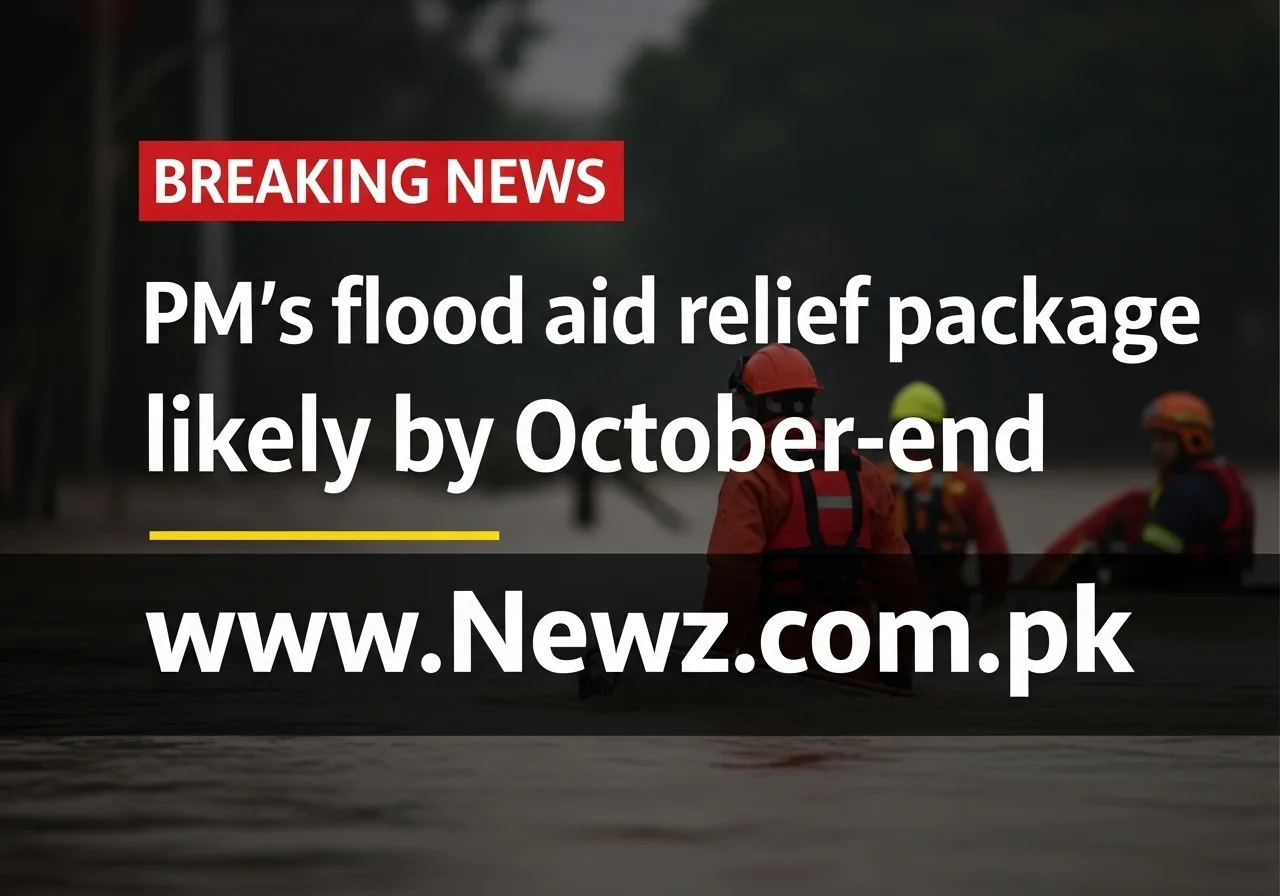PM’s Flood Aid Relief Package Likely by October-End: A Deep Dive
Introduction
In a recent development, a high-powered cabinet committee on agriculture, climate change, and flood emergencies convened to push forward a support package that Prime Minister Shehbaz Sharif is expected to announce by the end of October 2025. The meeting exposed significant gaps in coordination, commitment, and accountability within the federal and provincial leadership over the crucial task of flood-loss assessment. As floods have wrought devastating damage across Punjab and parts of Khyber Pakhtunkhwa, this aid package could make or break recovery paths for millions of farmers and vulnerable communities.
This article explores the political, logistical, and agricultural dimensions of the proposed aid package, the challenges ahead, and what different stakeholders can expect.
Background: The 2025 Floods in Pakistan
Scale of the Disaster
This year’s monsoon season, coupled with swollen river releases and climate anomalies, triggered one of the worst flooding events in recent memory across Pakistan. In Punjab alone, estimates suggest over 2.2 million hectares of farmland have been submerged, impacting millions of livelihoods. Some reports estimate that more than 4,500 villages have been inundated, affecting millions of farmers and residents.
In Khyber Pakhtunkhwa, flash floods and landslides added to the catastrophe, particularly in mountainous zones where infrastructure is already fragile.
The timing is harsh: the Rabi planting season is approaching, giving only a narrow window for rehabilitation and re-sowing of essential crops. The flood waters leave behind nutrient-rich moisture in soil—but without timely intervention, this advantage will be lost.
Agricultural & Economic Impact
Agriculture is the lifeblood of Pakistan’s rural economy. Roughly 37% of the workforce is tied to farming, and agriculture contributes about 24% of national GDP. When crops, livestock, and irrigation infrastructures are wiped out, the ripple effects hurt food security, rural incomes, supply chains, and inflation.
Crops like wheat, cotton, rice, and sugarcane—critical to both domestic consumption and export earnings—have been especially hard hit. Many farmers lost entire harvests. In Punjab, reports indicate crop losses on 2,500,000 acres have been recorded.
In response, provinces have started damage assessments, with Punjab approving Rs 20,000 per acre for crop losses in affected areas. Also, the provincial government approved compensation schemes for housing, livestock, and infrastructure losses.
The Cabinet Committee Meeting: Highlights & Tensions
Lack of Presence and Accountability
The first meeting of the newly constituted cabinet committee, led by Planning Minister Ahsan Iqbal, exposed deep fractures. Key federal ministers—responsible for finance, water resources, housing, climate change, and power—were either absent or sent low-level representatives. Similarly, Punjab and Sindh failed to attend in full, with Sindh’s absence particularly striking amid political tensions.
Mr. Iqbal strongly rebuked this apathy. He warned that such negligence over flood-loss assessment would be reported to the Prime Minister, calling the behavior inappropriate given the scale of the disaster.
When the absent ministers eventually arrived, the damage had already been done—the trust deficit was evident. In Punjab, a special secretary stood in, reflecting a reluctant or symbolic involvement at best.
Provincial Dynamics and Resource Claims
The meeting underscored a central issue: smaller provinces felt the aid package might be skewed in favor of Punjab and Sindh, due to political weight and agricultural scale. KP’s Finance Minister, Muzammil Aslam, emphasized that relief should align with NFC (National Finance Commission) shares, so that gas subsidies, fertilizer support, and compensation don’t disproportionately benefit large provinces.
KP’s Agriculture Minister highlighted the province’s proactive efforts: supplying free seeds and fertilisers, promoting olive and saffron cultivation, and engaging with the World Bank and ADB for support. He urged that KP’s contributions be recognized, not overshadowed.
Punjab, on its side, has reported crop losses across 2.5 million acres and set an ambitious target of 16.5 million acres for wheat sowing—up from last year’s 16.25 million. But Iqbal cautioned that targets without implementation plans are meaningless.
Task Forces and Timeline
To avoid delay, three task forces have been constituted:
Immediate agricultural relief and seed provision
Climate change adaptation, resilience strategies
Infrastructure strengthening for climate resilience
These teams will produce reports within 15 days, which will then be forwarded to the Prime Minister for final decision-making.
The consensus was that immediate, medium-term, and long-term assistance must be planned in parallel. One urgent push is for canola seed distribution within 15 days, to leverage the lingering soil moisture. A pilot 5,000-acre project in Narowal has already been launched via corporate sponsorship.
Interest-free loans and agricultural insurance are also being mooted as systemic safeguards against future climate shocks.
Expected Elements of the PM’s Flood Aid Package
While the definitive contents will be revealed by the Prime Minister, based on past precedents and discussions, the package is likely to include:
Cash subsidies / per-acre compensation (e.g., Rs 20,000 per acre in Punjab).
Housing and infrastructure compensation, with differentiated rates for concrete vs mud houses.
Compensation for livestock losses, from small animals to large.
Waivers on agricultural income tax and water charges (aabiana) in affected areas.
Interest-free or subsidized loans for farmers to re-sow for the Rabi season.
Subsidized inputs: seeds, fertilizer, and machinery support.
Support for alternative high-value crops, like canola or saffron.
Insurance & risk management schemes to protect against future floods.
Investments in resilient infrastructure, such as flood barriers, drainage, embankments.
Strengthened coordination and monitoring, with federal support to provinces.
Given the urgency, many of these must be initiated simultaneously rather than sequentially.
Key Challenges Ahead
1. Timely and Accurate Damage Assessment
Despite the urgent need, flood-loss assessments have lagged due to poor coordination between the Ministry of National Food Security and provincial bodies. Both sides appear to be waiting for each other, creating hazardous delays.
Further, inconsistent methodology, political bias, and lack of transparency may jeopardize legitimacy of aid distribution.
2. Political Will vs Bureaucratic Inertia
The absence of key ministers at the initial meeting illustrated institutional apathy. Even if the PM signs off, mobilizing ministries like power, water, finance, and housing to deliver quickly will be a serious test.
3. Fiscal Constraints
Pakistan’s economy is already under strain, and flood relief spending will stretch an already constrained budget. The IMF has flagged the need to review whether emergency allocations fit into fiscal prudence.
4. Provincial Disparities and Trust Deficit
Smaller provinces may perceive the aid package as biased. Ensuring equitable distribution—in line with NFC shares—is politically sensitive. KP’s insistence reflects legitimate concerns.
5. Implementation Capacity & Corruption Risks
Disbursing millions in cash, inputs, and loans across remote flood-hit areas raises the risk of duplication, fraud, and leakage. Real-time monitoring and robust audits will be crucial.
6. Climate Uncertainty and Further Flood Risk
Rains and water releases remain unpredictable. Punjab’s disaster management authority has already warned of potential flooding in the Sutlej region.
Strategic Opportunities & Innovations
Shift to High-Value Crops
The push for canola as a more lucrative alternative to wheat is smart. Given global prices (~$700/tonne vs. $250–$300 for wheat), canola offers greater margins and less water demand per yield. The pilot in Narowal is a promising start.
Crop Diversification & Climate-Resilient Varieties
Moving beyond monocultures to crops better suited to variable conditions (drought-tolerant, short-season cereals) will help buffer future shocks.
Modernizing Flood Warning & Monitoring
Pakistan is already investing in upgrading its hydromet system under the Modernised Hydromet Services Program (MHSP) to give real-time, advanced alerts. This becomes vital for proactive response.
Insurance & Risk Transfer Mechanisms
Encouraging private or parametric crop insurance can protect farmers from rainy-year devastation. The government might subsidize premiums initially.
Better Water Management
Long-term reforms must include controlling groundwater over-exploitation—and regulating proliferation of solar-powered tube wells, which some studies suggest worsen aquifer depletion.
Integrated Policy & Institutional Coordination
A permanent National Flood Response Unit, combining NDMA, PDA, Planning, Agriculture, and Water Ministries, could centralize data, funding, and execution during disasters.
What Farmers & Affected Communities Should Do
Document losses: photographs, field-level records, receipts—this supports claims.
Engage local representatives and agricultural officers to push for inclusion in assessments.
Start soil preparation as waters recede and the package begins.
Seek farmer groups and cooperatives to negotiate bulk inputs or credit.
Push for transparency: demand public dashboards on disbursements, task force reports, audits.
What to Expect from October End Onwards
The Prime Minister’s package may be formally announced in the final week of October, after receiving task force recommendations.
Disbursements of compensation and input support might begin in early November (subject to approval).
Pilot initiatives, like canola seed deployment, should start immediately in moisture-rich fields.
Provinces like Punjab will start executing their own relief programs: housing compensation, livestock support, infrastructure rehabilitation.
Monitoring and adjustments will be essential: provinces under pressure may veto or delay parts of the package.
The real test will be the Kharif and Rabi seasons: if farmers can replant successfully, recovery is possible; if not, food security and costs will spiral.

Frequently Asked Questions (FAQs)
Q1: Why is the aid package expected by October-end?
A: Because the Rabi planting window is short. Delays beyond October risk losing the moisture benefit and opportunity to re-sow. The cabinet set a 15-day task force deadline to accelerate planning.
Q2: What are the likely compensation rates for farmers?
A: Punjab has approved Rs 20,000 per acre for crop losses. Additional packages may include livestock, housing, and infrastructure compensation.
Q3: Will smaller provinces like KP get fair share?
A: KP leaders have demanded allocations based on NFC shares rather than fixed amounts. Whether this is honored depends on the final finance mechanism.
Q4: Can farmers use the soil moisture left by floods?
A: Yes—that’s why rapid distribution of canola seeds is emphasized, and a pilot has already been launched in Narowal.
Q5: Will the package include long-term climate resilience measures?
A: Yes. One task force is dedicated to this, aiming to strengthen flood infrastructure, adopt resilient crops, and modernize systems.
Q6: How will the aid be monitored to prevent misuse?
A: The package is expected to include monitoring dashboards, audits, and transparency mechanisms. Provinces and federal bodies will likely coordinate for oversight.
Conclusion
The looming flood aid package, expected by October-end, is a make-or-break moment for millions of Pakistan’s farmers and flood-affected communities. While the federal government has acted swiftly to form task forces and allocate planning leadership, the execution challenge remains enormous. Success will hinge on solid coordination, political commitment, transparency, and speed.
If properly deployed, the package could not only rescue this year’s crop loss but also set the foundation for better climate resilience, agricultural modernization, and trust between federal and provincial governments. Time is the most precious currency now—and every day of delay pushes recovery further out of reach.






